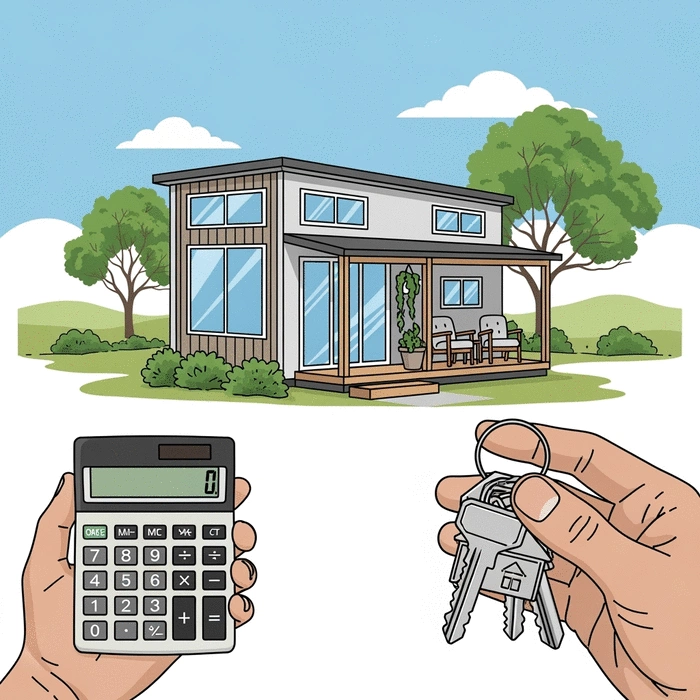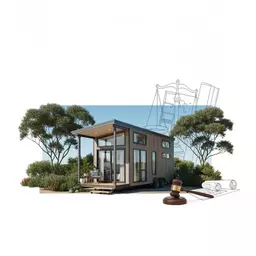Personal Loans
Quick access to funds with minimal requirements.
- Flexibility in terms of amounts.
- Higher interest rates compared to mortgages.
Get expert advice, innovative design ideas, and practical tips for your tiny home journey in Australia.
Posted on: 2025-10-26
By: Sophie Marchant
With over 60% of Australians considering downsizing their living space, tiny houses are not just a trend; they represent a shift towards financial independence and sustainability. Are you ready to explore the world of tiny house financing and discover how it can transform your lifestyle?
Understanding various financing options can simplify your tiny house journey. Below are the essential financing types available for tiny home buyers, along with their pros and cons. If you're pondering which tiny home is right for you, exploring different financing avenues is just as important as choosing your ideal tiny home.
Quick access to funds with minimal requirements.
Specialized loans for eco-friendly homes.
Lenders focusing on tiny home financing.
Community-based financial institutions that may have favorable terms.
As many Australians embrace the concept of tiny living, the tiny house movement continues to gain traction. This lifestyle not only promotes sustainability but also offers financial freedom from the burdens of large mortgages. At The Tiny Living Guide, we aim to provide you with insights about navigating the complexities of tiny house financing so you can embark on your own journey towards a minimalistic lifestyle!
The tiny house movement in Australia is all about simplifying life and reducing environmental impact. Many people are drawn to small, efficient living spaces that reflect their personal values. As this movement grows, more individuals are realizing that they can live comfortably in smaller homes, often without the hefty financial commitment associated with traditional housing. This shift also encourages consideration of sustainable living in tiny homes, further reducing their ecological footprint.
Interestingly, tiny homes vary significantly—from mobile structures to fixed dwellings, catering to diverse lifestyles. The movement has sparked a sense of community among those interested in sustainability, drawing in both young and older generations alike. Have you ever considered joining this vibrant community? It's an exciting time to explore what tiny living can offer!
When it comes to purchasing a tiny home, understanding your financing options is crucial. Unlike traditional homes, securing funds for tiny houses can be challenging due to their unique classifications. Having a clear grasp of available financing options helps you make informed decisions, ensuring that you find a solution that fits both your needs and your budget.
By exploring your financing options, you’re setting yourself up for success in the tiny home journey. Whether you’re considering a personal loan or a green financing option, knowing your choices allows you to take control of your financial future. Let’s discover the possibilities together!
With the growing popularity of tiny homes, there are numerous financing options available to potential buyers. Each option comes with its own set of pros and cons, making it vital to evaluate what works best for your situation. At The Tiny Living Guide, we’re committed to helping you understand these options clearly so you can make the best choice for your tiny living adventure!
Here's a brief recap of the key points discussed so far:
Securing financing for your tiny home can feel overwhelming, but with the right steps, you can improve your chances of approval. First and foremost, consider evaluating your financial health. This means looking at your credit score, income, and current debts. By taking stock of your finances, you can identify areas for improvement and present yourself as a strong candidate to lenders.
Next, it’s essential to gather all necessary documentation. Lenders will want to see proof of income, bank statements, and any other relevant financial records. Organizing these documents ahead of time can streamline the application process and enhance your credibility. What else can you do? Let’s take a look at some actionable steps!
Choosing the right finance broker or lender is crucial for your tiny house journey. A good broker can help you navigate various financing options and tailor solutions that fit your unique needs. Start by asking for recommendations from friends or family who have experience with tiny home financing. You can also check online reviews to gauge the reputation of potential brokers. Understanding key questions for modular home buyers can also provide helpful insights into the financing process, as some tiny homes share characteristics with modular construction.
Remember to ask the right questions during your search! Understanding their experience with tiny homes will help you find someone who is familiar with the nuances of this market. Here are some tips to consider:
When you finance a tiny home, it's vital to consider the ongoing expenses that come with it. Unlike traditional homes, tiny houses can have unique costs that might catch first-time buyers off guard. Besides your loan payments, you'll need to plan for maintenance, utilities, and property taxes, which can add up over time. For those interested in the legalities of where they can place their tiny home, understanding tiny house zoning laws is equally important to avoid unexpected costs or issues.
Don’t forget about insurance! Protecting your investment is essential, and tiny house insurance can vary significantly from standard homeowners' insurance. Understanding your options will help you choose the best coverage for your situation. Here are some ongoing expenses you should keep in mind:
Insurance for tiny homes can be a bit tricky, but it's a crucial aspect of financing. You'll want to ensure that you have coverage that suits your specific living situation. Tiny homes may require specialized insurance policies, especially if they're mobile or located on a trailer. Here are a few options to consider:
It's essential to shop around and compare policies to find the best fit for your needs. Remember, your tiny home is not just a house—it's a lifestyle choice. Ensuring that you have the right coverage will give you peace of mind as you embrace this exciting journey!
As we wrap up our exploration of tiny house financing, it’s important to recap the key options available to you. From personal loans to green financing, understanding your choices will help you make informed decisions. Remember, the right financing can set you on the path to a more sustainable lifestyle with less debt.
So, are you ready to take action? Explore your financing options today! The tiny house community is here to support you, and with resources like The Tiny Living Guide, you can navigate this journey more easily. Let’s make your dream of tiny living a reality!
Here is a quick recap of the important points discussed in the article:

 What if your small living space could also be a sanctuary for the planet? Embracing sustainability n
What if your small living space could also be a sanctuary for the planet? Embracing sustainability n
 As the tiny home movement gains momentum in Australia, the legal landscape can feel daunting. Howeve
As the tiny home movement gains momentum in Australia, the legal landscape can feel daunting. Howeve
 Did you know that zoning laws can significantly impact the feasibility of sustainable housing initia
Did you know that zoning laws can significantly impact the feasibility of sustainable housing initia